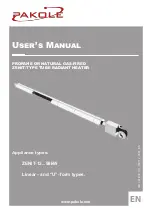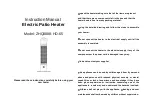
19
UN-LIME
®
Professional Delimer is an easy to handle patented food
grade acid formulated specifically for lime scale removal from all
types of water using equipment. Hydrochloric base acids must not
be used to delime the water heaters covered in this manual.
Follow the instructions on the UN-LIME
®
to delime the water heater.
Note:
Contact Technical Support for assistance in ordering the UN-
LIME
®
Professional Delimer.
ANODE MAINTENANCE
Avoid damage.
Property Damage Hazard
Inspection and replacement of anode rod required.
The anode rod is used to protect the tank from corrosion. Most hot
water tanks are equipped with an anode rod. The submerged rod
sacrifices itself to protect the tank. Instead of corroding tank, water
ions attack and eat away the anode rod. This does not affect water’s
taste or color. The rod must be maintained to keep tank in operating
condition.
Anode deterioration depends on water conductivity, not necessarily
water condition. A corroded or pitted anode rod indicates high water
conductivity and should be checked and/or replaced more often than
an anode rod that appears to be intact. Replacement of a depleted
anode rod can extend the life of your water heater. Inspection should
be conducted by a qualified technician, and at a minimum should
be checked annually.
Artificially softened water is exceedingly corrosive because the
process substitutes sodium ions for magnesium and calcium ions.
The use of a water softener may decrease the life of the water
heater tank.
The anode rod should be inspected annually.
The following are typical (but not all) signs of a depleted anode rod:
•
The majority of the rods diameter is less than 3/8”.
•
Significant sections of the support wire (approx. 1/3 or more of
the anode rod’s length) are visible.
Figure 5. Anode Depletion
If the anode rod show signs of either or both it should be replaced.
Note:
Whether re-installing or replacing the anode rod, check for
any leaks and immediately correct if found.
Dot the following to replace the anode:
1.
Turn off the power supply to the water heater.
2.
Shut off the water supply and open a nearby hot water faucet to
depressurize the water tank.
3.
Drain approximately 5 gallons of water from tank. See
Draining and
Flushing
(page 18) for proper procedures. Close drain valve.
4.
Remove old anode rod.
5.
Use Teflon
®
tape or approved pipe sealant on threads and install
new anode rod.
6.
Turn on water supply and open a nearby hot water faucet to purge
air from water system. Check for any leaks and immediately
correct any if found.
7.
Restart the water heater as directed in this manual. See
Figure 1
(page 8) for anode rod location.
TEMPERATURE-PRESSURE RELIEF VALVE TEST
It is recommended that the Temperature-Pressure Relief Valve
should be checked to ensure that it is in operating condition every
6 months.
When checking the Temperature-Pressure Relief Valve operation,
make sure that (1) no one is in front of or around the outlet of the
Temperature-Pressure Relief Valve discharge line, and (2) that the
water discharge will not cause any property damage, as water may
be extremely hot. Use care when operating valve as the valve may
be hot.
To check the temperature-pressure relief valve, lift the lever at the
end of the valve several times. See
Figure 6
. The valve should seat
properly and operate freely.
If after manually operating the valve, it fails to completely reset and
continues to release water, immediately close the cold water inlet to
the water heater and drain the water heater. See
Draining and Flushing
(page 18). Replace the Temperature-Pressure Relief Valve with
a properly rated/sized new one. See
Temperature-Pressure Relief Valve
(page 12) for instructions on replacement.
Figure 6. Testing the Temperature-Pressure Relief Valve
If the Temperature-Pressure Relief Valve on the water heater weeps
or discharges periodically, this may be due to thermal expansion.
Note:
Excessive water pressure is the most common cause of
Temperature-Pressure Relief Valve leakage. Excessive water
system pressure is most often caused by “thermal expansion”
in a “closed system.” See
Closed Water Systems
(page 13)
and
Thermal Expansion
(page 13). The Temperature-Pressure
Printed on 7/25/2022 7:17 AM CT






































